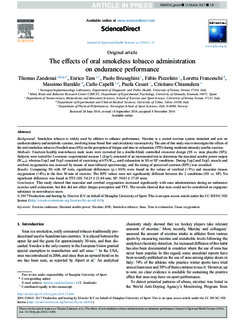The effects of oral smokeless tobacco administration on endurance performance
Zandonai, Thomas; Tam, Enrico; Bruseghini, Paolo; Pizzolato, Fabio; Franceschi, Loretta; Baraldo, Massimo; Capelli, Carlo; Cesari, Paola; Chiamulera, Cristiano
Peer reviewed, Journal article
Published version
Permanent lenke
http://hdl.handle.net/11250/2564248Utgivelsesdato
2017Metadata
Vis full innførselSamlinger
- Artikler / Articles [2119]
Originalversjon
Journal of Sport and Health Science. 2017, under utgivelse. 10.1016/j.jshs.2016.12.006Sammendrag
Background: Smokeless tobacco is widely used by athletes to enhance performance. Nicotine is a central nervous system stimulant and acts on cardiocirculatory and metabolic systems, involving tissue blood flow and circulatory vasoreactivity. The aim of this study was to investigate the effects of the oral smokeless tobacco (Swedish snus (SS)) on the perception of fatigue and time to exhaustion (TTE) during moderate-intensity aerobic exercise. Methods: Fourteen healthy non-tobacco male users were recruited for a double-blind, controlled crossover design (SS vs. snus placebo (SP)). Subjects were tested for 3 sessions: experimental session 1 (Exp1) consisted of an incremental test to determine the maximal aerobic power output (Wmax), whereas Exp2 and Exp3 consisted of exercising at 65%Wmax until exhaustion in SS or SP conditions. During Exp2 and Exp3, muscle and cerebral oxygenation was assessed by means of near-infrared spectroscopy, and the rating of perceived exertion (RPE) was recorded. Results: Comparing SS with SP tests, significant differences (p <0.05) were found in the values of cerebral (~3%) and muscular tissues oxygenation (~4%) in the first 30 min of exercise. The RPE values were not significantly different between the 2 conditions (SS vs. SP). No significant difference was found in TTE (SS: 54.25 ± 21.84 min; SP: 50.01 ± 17.03 min). Conclusion: This study showed that muscular and cerebral oxygenation increased significantly with snus administration during an endurance exercise until exhaustion, but this did not affect fatigue perception and TTE. The results showed that snus could not be considered an ergogenic substance in non-tobacco users.
Beskrivelse
This is an open access article under the CC BY-NC-ND license (http://creativecommons.org/licenses/by-nc-nd/4.0/).
